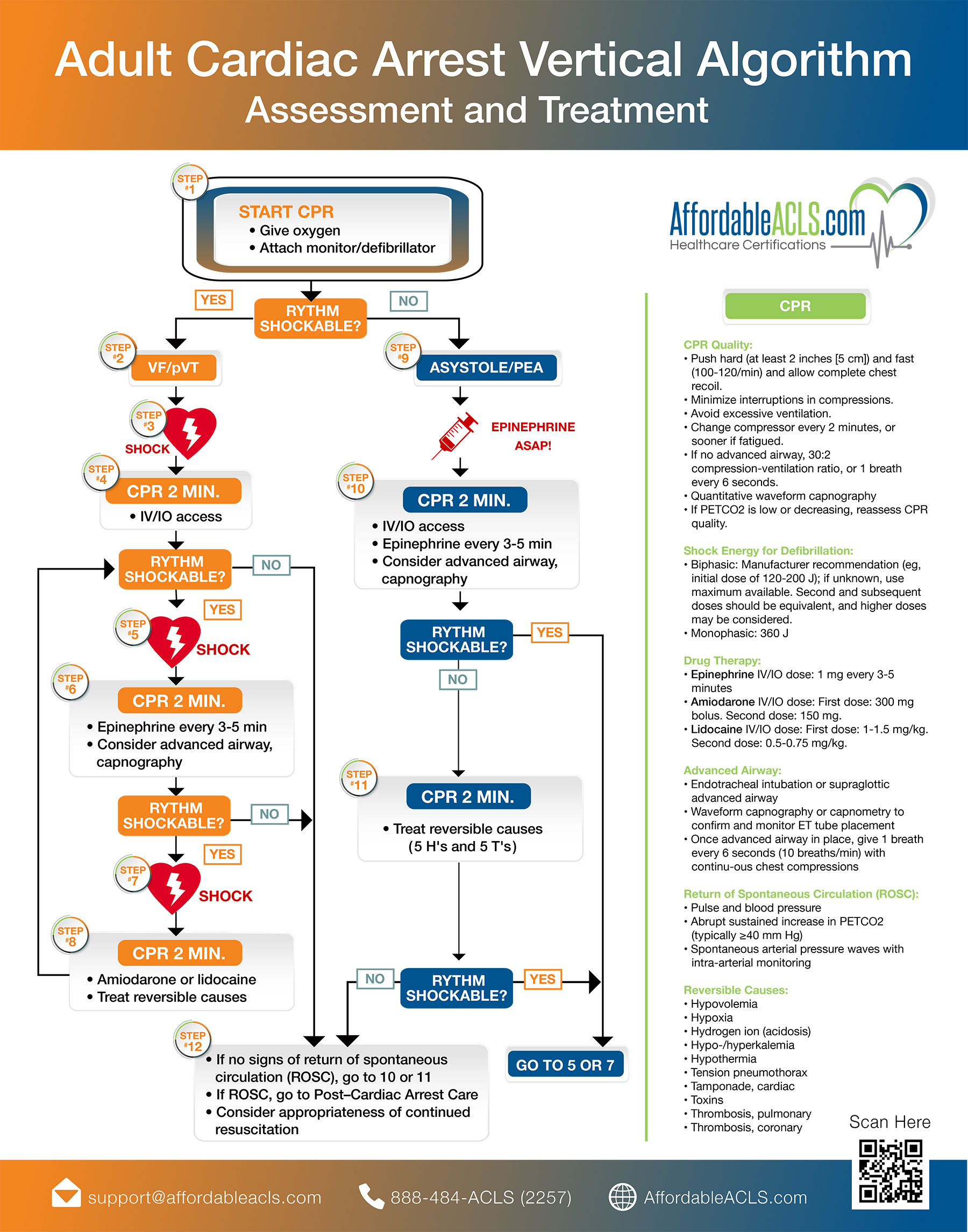Primary Algorithm of ACLS. Can include asystole, PEA, ventricular fibrillation, and pulseless ventricular tachycardia.
The following steps outline the primary algorithm in ACLS.
Step 1. Start CPR. Start CPR with hard and fast compressions, around 100 to 120 per minute, allowing the chest to completely recoil. Give the patient oxygen and attach a monitor or defibrillator. Make sure to minimize interruptions in chest compressions and avoid excessive ventilation, using a 30 to 2 compression-to-ventilation ratio if no airway is established.
Rhythm shockable? Conduct a rhythm check, making sure the pause in chest compressions is not more than 10 seconds.
Step 2. VF/pVT (Shockable rhythm). If a shockable rhythm is present, either v-fib or pulseless v-tach, begin the charging sequence on the defibrillator and resume chest compressions until the defibrillator is charged.
Step 3. Shock. When the defibrillator is charged, announce the shock warning and make sure no one is touching the patient. Shock the patient with an initial dose of 120 to 200 joules.
Step 4. CPR – 2 min. Immediately resume CPR for 2 minutes, and establish IV access.
Rhythm Shockable? Check for pulse and rhythm for no more than 10 seconds every 2 minutes.
No. If the patient shows signs of return of spontaneous circulation, or ROSC, administer post-cardiac care. If a nonshockable rhythm is present and there is no pulse, continue with CPR and move to the algorithm for asystole or PEA.
Step 5. Yes – Shock. If the rhythm is shockable, announce the shock warning and make sure no one is touching the patient. Administer the shock.
Step 6. CPR – 2 min. Continue with CPR for 2 minutes. Give the patient a vasopressor such as epinephrine every 3 to 5 minutes, and consider advanced airway and capnography, giving 1 breath every 6 seconds once the advanced airway is in place.
Rhythm Shockable? Check for pulse and rhythm for no more than 10 seconds every 2 minutes.
No. If the patient shows signs of return of spontaneous circulation, or ROSC, administer post-cardiac care. If a nonshockable rhythm is present and there is no pulse, continue with CPR and move to the algorithm for asystole or PEA.
Step 7. Yes – Shock. If the rhythm is shockable, announce the shock warning and make sure no one is touching the patient. Administer the shock.
Step 8. CPR – 2 min. Continue with CPR for 2 minutes. Consider giving the patient an antiarrhythmic drug such as amiodarone for refractory v-fib or pulseless v-tach, and treat reversible causes. Use Hs and Ts to remember: hypovolemic, hypoxia, hydrogen ions, hypo and hyperkalemia, hypothermia, tension pneumo, tamponade, toxins, and thrombosis.
Step 9. Asystole/PEA. If a nonshockable rhythm is present, and the rhythm is organized, check for a pulse. Make sure the pause in chest compressions to check the rhythm is not more than 10 seconds.
Step 10. CPR – 2 min. Continue with CPR for 2 minutes, and establish IV access. Give the patient a vasopressor such as epinephrine every 3 to 5 minutes, and consider advanced airway and capnography, giving 1 breath every 6 seconds once the advanced airway is in place.
Rhythm Shockable? Check for pulse and rhythm for no more than 10 seconds every 2 minutes.
Yes. If the rhythm changes to a V-fib or V-tach shockable rhythm, move to that algorithm and prepare to shock the patient.
Step 11. CPR – 2 min. If a nonshockable rhythm is still present with no pulse, continue with CPR for 2 minutes, and treat reversible causes. Use Hs and Ts to remember: hypovolemic, hypoxia, hydrogen ions, hypo and hyperkalemia, hypothermia, tension pneumo, tamponade, toxins, and thrombosis.
Rhythm Shockable? Check for pulse and rhythm for no more than 10 seconds every 2 minutes.
Yes. If the rhythm changes to a V-fib or V-tach shockable rhythm, move to that algorithm and prepare to shock the patient.
Step 12. CPR – 2 min. If the patient shows signs of return of spontaneous circulation, or ROSC, administer post-cardiac care. If a nonshockable rhythm is present and there is no pulse, continue with CPR.

